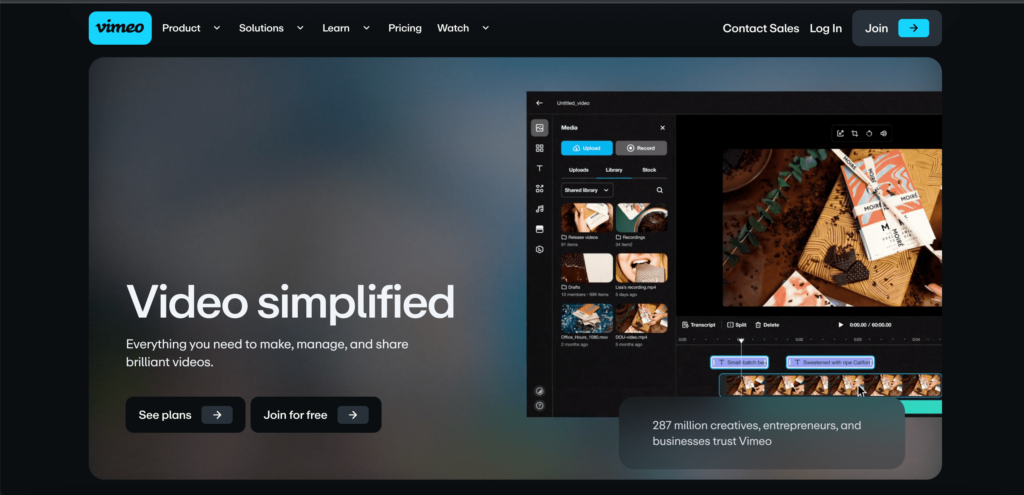Comparing the Top 4 Vidyard Alternatives
April 4, 2024 | by Shahan Syed

If you’re looking for a video platform to upload and share videos for sales purposes or in general, you might have come across Vidyard in your online searches. Whether you’re procuring a new platform or replacing your existing one, it might be a good idea to look into alternatives to Vidyard.
Vidyard (or a similar platform) can help you upload your videos, store them in a library, and then share them as needed. These platforms differ amongst themselves in terms of how you plan to use videos; externally facing communications or internal. Each has its area of expertise with a depth of features in that domain.
This article compares 4 different Vidyard alternatives in depth. We initially discuss the pros and cons of Vidyard and then compare it with its competitors.
Why choose Vidyard for video sharing?
Here are the reasons why you would or wouldn’t want to opt for Vidyard:
Pros
- Generous limits in terms of the number of videos you can share.
- Seamlessly integrates with email providers for salespeople to quickly add videos.
- Offers simple in-built recording capabilities for salespeople to record messages.
- Seamlessly integrates with your CRM to track the impact of videos across your funnel.
Cons
- Has a limit on the number of videos you can embed on the free and starting plan.
- There’s no functionality to create video portals.
- Has no video access management for internal sharing of video content.
- Limited video security features as it only offers password protection.
Comparing Top 4 Vidyard Alternatives
Streamable

If you’re not looking for a lot of features, then Streamable is a budget-friendly option, which gets you more videos in less price.
Streamable offers a no-frills platform with basic capabilities to upload, store and share videos. You can also embed videos on your website, with no limits in place.
However, you don’t get any of the fancy stuff like integrations, analytics, forms, video portals, etc. The free plan also has a 10-minute video limit in place and the video expires after 90 days.
Pros
- Low price that offers great value for money.
- You can embed videos with no limits.
- Offers basic video editing tools.
- Offers generous video storage on all plans to store large amounts of videos.
Cons
- Ads play in the free version, whereas in Vidyard you get no ads.
- Videos expire in 90 days on the free plan.
- Not suited for internal video sharing.
- Little to no video security features.
Vimeo

Unlike Vidyard, which is a platform that is sales-focused, Vimeo is a general-purpose video platform. It offers the capabilities to allow you to upload and share videos for any purpose; be it publicly available marketing videos or internal sharing for training purposes.
Vimeo allows you to create an internal video library for sharing content only with your employees or select individuals. It also offers a permissions management system, allowing you to define for every video as to which individual users or groups of users can access it.
Vimeo also offers more advanced features such as monetization, custom branding, AI-generated closed captions and more.
Pros
- Great video creation from templates.
- Great video recording capabilities.
- Permissions management allows for secure internal video sharing.
- Monetization capabilities are available.
- Advanced video security features are available, such as domain restrictions.
Cons
- The price per user is high and can be costly for large teams.
- Strict restrictions are in place for the number of videos you can upload.
- Limited integrations are available.
- Interactive elements are relatively simple.
Wistia

Wistia is another platform that is suited for marketing and sales purposes. It emphasizes more on the marketing side of things as most of its features are better at this.
Their homepage basically spells out the message “Your one-stop video marketing shop”.
It offers all the basic features needed to create, upload, host and share videos. But more importantly it offers marketing features that other platforms don’t offer.
These marketing features include great A/B testing functionality, interactive forms, SEO features including automatic ingestion of schema into the head of your page, and lastly some great video analytics.
Pros
- Great functionality to record videos.
- Great SEO features.
- Detailed video analytics are available.
- Wide range of integrations available, with an emphasis on marketing-related ones.
Cons
- Strict video limits in terms of number of videos and their length.
- Permissions system is basic and hence makes the platform less suited for internal sharing.
- Basic AI features available.
- Limited monetization capabilities.
Kaltura

Kaltura is a video platform for large enterprises. Unlike others on the list, it offers capabilities and the scalability that is needed by large enterprise customers.
If you’re an enterprise looking for a video platform for a large number of internal users, or to scale a large global audience, then you might want to look into Kaltura.
The great thing about Kaltura is that it has multiple video products, each designed for a different video use case. Depending on your use case, you can pick the best product(s) and achieve your objectives.
Pros
- Highly scalable and performant platform.
- Has products for every video use case.
- Offers an API-first solution as well to enable you to build on your terms.
- Wide range of integrations are available.
Cons
- It’s costlier than the other options on this list.
- Doesn’t offer innovative AI capabilities.
- You’ll need an in-house IT and development team to unlock its full potential.
- Most of its customers are in the media, telecom and education industries. Companies in other industries might not find the best product-fit.
RELATED POSTS
View all


